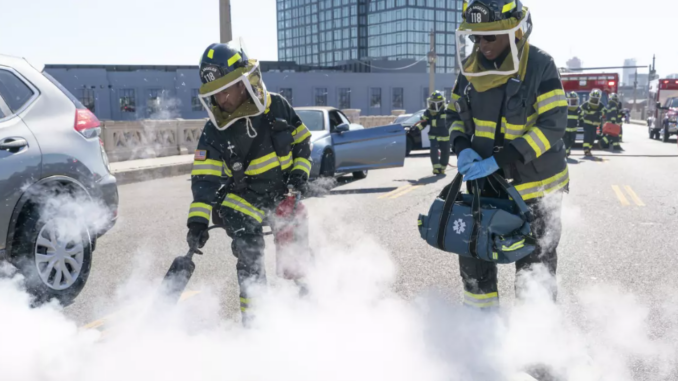
Despite never having seen a “9-1-1” episode before Season 8 debuted, the first-responder procedural shot to the top of my must-watch list after seeing the “Bee-nado” commercials on TV. And online. And even on an unaffiliated streaming service. The three-part event concludes with the episode “Final Approach,” which debuts Thursday on ABC.
The season opener in September is the aptly titled “Buzzkill,” which begins with a pilot losing control of his small plane after flying into a giant swarm of bees. This causes him to collide with a larger passenger plane.
The episode then reveals that a broken-down large truck released 22 million killer bees into L.A. when it crashed into the 4th Street Bridge. After arriving at the scene to assist those affected by the car crash, including a pair of passengers trapped in their bee-infested car, a firefighter looks up at the sky and says, “It’s a bee-nado.”
The over-the-top events cleverly channel the killer bee mania of the 1990s as well as the made-for-TV sci-fi disaster movies of yore, making “Bee-nado” both a little crazy and strange but comforting.
The plot gets wilder and wilder—in the most stereotypical L.A. way—as the episode progresses. Without giving anything away, “Buzzkill” uses Nikolai Rimsky-Korsakov’s “Flight of the Bumblebee” as a memorable pin drop.
But there’s no need to recount the plot’s twists and turns to explain why the “Bee-nado” incident highlights the unique power of broadcast network television. Created by Ryan Murphy, Brad Falchuk and Tim Minear, “9-1-1” is an hourlong drama that follows the lives and intersecting emergencies of firefighters, police officers and 911 dispatchers. More than 100 episodes of the L.A.-set show have aired since its 2018 debut, meaning the main characters have been fleshed out over years of storytelling.
But “Buzzkill” is completely newbie-friendly. Tracking a swarm of killer bees causing a plane crash is easy to follow, whether you know the character’s name is Athena Grant or you call her “the cop played by Angela Bassett.” That’s part of the reason the procedural format continues to thrive in an ever-changing television landscape. The success of shows like “Law & Order,” “CSI,” “Criminal Minds,” and “NCIS” has spawned major spinoffs. Even “9-1-1” has its own spinoff.
Procedural shows endure because the format is familiar, accessible, and addictive. Typically, these shows are episodic — meaning most episodes tell standalone stories rather than serving as chapters in a single narrative. This makes it easy for casual viewers, who may not watch every episode, to finish the show. Meanwhile, loyal viewers are rewarded with episodic elements, like character development and relationships that evolve over the course of each season.
The second episode of the three-part series, titled “When the Boeing Gets Tough,” features some minor hijinks, but the central emergency is equally compelling and bizarre. After a plane’s captain is sucked out of a hole in the cockpit created by a midair collision, the passengers must care for each other with some emergency medical instructions from afar. A temporary life-saving procedure requires administering erectile dysfunction medication via nebulizer.
Shows like “9-1-1” are compelling because they can put characters in increasingly unlikely, if not impossible, situations—the kind that can leave a new fan hooked after eight seasons—while relying on friendship, romance, and other conventional storytelling tricks to keep attention amid the disasters. Plus, over-the-top emergencies like dam bursts, earthquakes, tsunamis, and a pirate attack on a cruise ship, at least when told in procedural language, are an escape from the more mundane horrors of everyday life.
With streaming services and premium cable networks dominating the “prestige” TV market, prioritizing long-form narratives over compelling episode counts and seasons, shows like “9-1-1” are a welcome relief.
Hopefully the end of the “Bee-nado” event will bring some closure to the fate of the killer bee superswarm. Time for another disaster next week.
